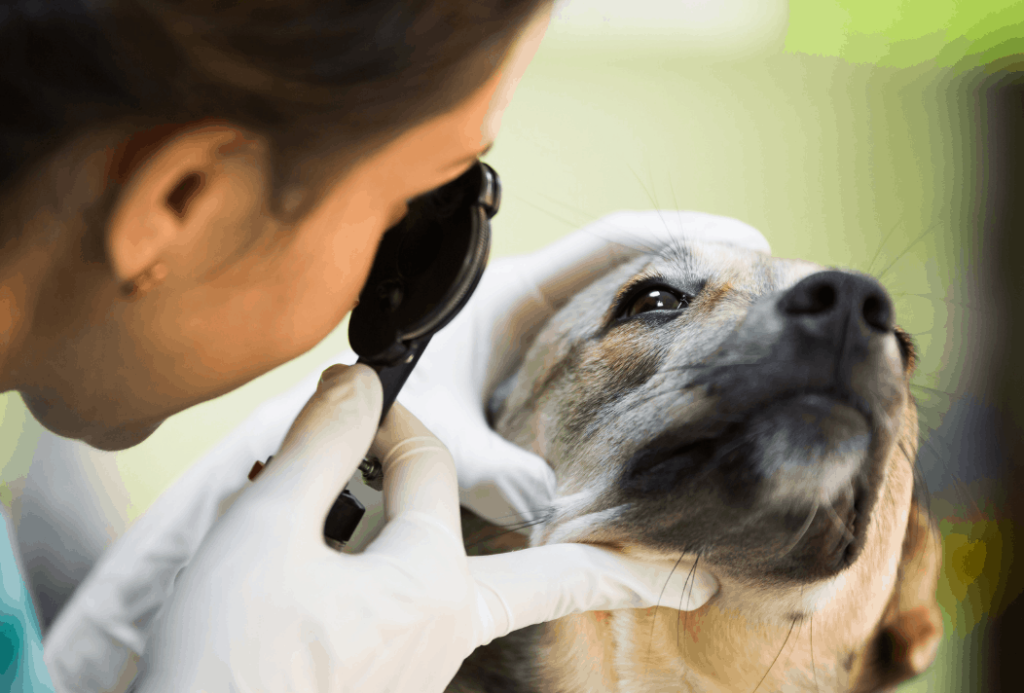A common but scary thing to see in older dogs is a neurologic condition that is often referred to as old dog syndrome. The name came about as it tends to occur most commonly in older dogs.
Old dog syndrome is actually more correctly referred to as vestibular disease.
If your dog develops vestibular disease it can seem like your dog has had a stroke, with clinical signs such as a head tilt, walking in circles, and even falling over.
What is vestibular disease or old dog syndrome?
The vestibular system is largely responsible for helping the body maintain normal balance and posture. There are several components, with the main ones being part of the brain as the central system, and other parts existing within the inner and middle ear.
What generally happens with vestibular disease is a loss of balance, and it typically presents with a rapid onset. One of the ways it can be diagnosed is that it doesn’t often progress past the signs present at initial onset.
Dogs with vestibular disease may be unbalanced or disoriented. Many show a head tilt and may circle in the direction of the head tilt. When your veterinarian examines your dog, they may notice nystagmus, which is a rapid jerking eye movement, often side to side or up and down.
What causes vestibular disease?
Vestibular disease has many potential causes, generally things that disrupt the normal functioning of the vestibular system.
Ear infections
This can include severe ear infections, especially those that affect the middle and inner ear canals.
Toxic medications or foods
Things that affect the ears, such as toxic medications, can also cause vestibular disease.
Brain tumors or trauma
Brain tumors or trauma are potential causes, and the common canine health condition hypothyroidism, or low thyroid function, is also associated.
Sometimes a cause can’t be identified
Unfortunately, many cases have no identifiable cause although they are thought to be caused by inflammatory processes, and these are referred to as idiopathic vestibular disease.
When diagnosing vestibular disease it’s important to rule out other neurologic issues
Diagnosing vestibular disease is often based on clinical signs and how your dog presents to the veterinarian. This generally has to be differentiated from other neurologic issues such as a stroke, a fibrocartilaginous enfarct (FCE), or a seizure.
Thankfully, a stroke and FCE are relatively uncommon. Seizures are much more common in dogs but typically result in a loss of consciousness, while vestibular disease dogs are usually conscious and responsive: they just have trouble getting around.
Symptoms of vestibular disease in dogs
Your dog may have a head tilt
The head tilt which can vary from being a smidgeon held to the side or an extreme tilt to the left or right. If your dog is able to walk, they may walk in circles or roll, often in the direction of their head tilt, meaning that if their head is tilting to the right, they will likely circle to the right.

Dizziness and lack of balance
Many pets act dizzy and may fall down when walking. They will often not try to run and may just stand hesitantly to keep from falling over.
Nausea and vomiting
Because of the effects on the vestibular system, dogs with vestibular disease may be nauseated, and some will even be active vomiting.

What to do if your dog has vestibular disease
Take your dog to the vet
When your dog presents with possible signs of vestibular disease, your veterinarian is going to start by taking a careful history, followed by a thorough physical exam, looking for signs such as a head tilt and nystagmus.
Tell the vet about any medications your dog is on, or any foods that may have been toxic
When answering the vet’s questions, you should let them know about any medications you have been giving your dog, as well as potential foods, especially human foods, as some such as macadamia nuts can be very toxic to dogs.
As part of that exam, your veterinarian will look into your dog’s eyes and ears, checking for evidence of other health issues that could be causing the problem, such as an ear infection.

Diagnostics are performed to rule out other potential causes
Blood work and a urinalysis are often used to check for evidence of an infection, as well as to look for other complicating factors such as hypothyroidism. More in-depth diagnostics are sometimes required, such as radiographs or X-rays of the head to assess the inner ears or MRI or CT scans.
How is vestibular disease treated?
Treating vestibular disease often depends on the cause. Many of these dogs need supportive care because they are dizzy and nauseated. Here are a few different scenarios that you may encounter if your dog develops vestibular disease:
Intensive hospitalization and IV fluids
If your dog cannot walk or eat, to ensure that they stay hydrated, intensive hospitalization may be needed. If they have been exposed to potentially hazardous foods or medications, decontamination may also be necessary, with IV fluids given to flush out their system.
Topical ear medications and antibiotics
Ear infections are often treated with topical ear medications and ear cleaning, although severe infections, especially involving the inner ear, will often necessitate antibiotic therapy. Other infections may also require antibiotics to treat.
Anti-nausea medication
For your pet’s vestibular signs, your veterinarian will often use an anti-nausea type medication. The most common types used in veterinary medicine are Cerenia (also known as maropitant) and meclizine.
Anti-anxiety or sedative
If your pet is very anxious or stumbling around a great deal, your veterinarian may also prescribe an anti-anxiety medication or sedative to help them stay calm. You will also need to provide plenty of supportive care to your older pup, which may involve sling walking them for support outside.
A simple bland diet
Bland diets can help with signs of nausea, such as feeding a prescription diet or equal amounts of chicken and rice, boiled with no seasonings until done.
Do dogs recover from vestibular disease?
The good news with vestibular disease is that, just as the onset is rapid, so too is recovery. Most dogs start to feel more like themselves within 2 to 3 days, although it can take a few weeks for a more complete recovery.
Some dogs have some lingering residual signs, such as a lingering head tilt or wobbling, for the rest of their lives. If your dog is not improving or starts to worsen, your veterinarian will need to look for other potential causes of their health issue, such as a brain tumor. These cases are ones that often necessitate more involved diagnostics, such as advanced brain imaging like an MRI.
Vestibular disease can be frightening but most dogs make a quick recovery
Vestibular disease in dogs can be scary and make you think of potential health issues such as a stroke. Fortunately, many dogs recover completely, but it is important to get them into the veterinarian where they can be evaluated, especially as many dogs need some level of supportive care to get them through the condition.









